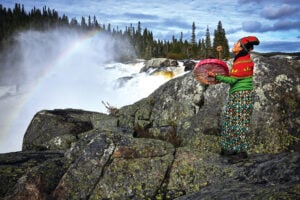
History
Frozen in time: The remarkable legacy of Mary Vaux, amateur glaciologist
Mary Vaux’s groundbreaking 19th-century study of B.C.’s Illecillewaet Glacier created an invaluable record of the glacier’s recession
- 4293 words
- 18 minutes
This article is over 5 years old and may contain outdated information.
Environment

For approximately the past 300 years the meltwater of Yukon’s Kaskawulsh Glacier has drained into Kluane Lake via Slims River. This spring it stopped.
The reason, according to Kristen Kennedy, a surficial geologist with the Yukon Geological Survey, is that the Kaskawulsh Glacier has now retreated to a point where the water that once flowed into the Slims is now flowing in the other direction, into the Kaskawulsh River.
“The drainage of the Kaskawulsh is very active,” Kennedy says. “It’s not unusual to see big variations in flow between the two rivers.”
Although, Kennedy says, seeing the Slims disappear is unprecedented, if not exactly a surprise. “There is a really interesting geographical story about the Slims,” Kennedy says. “The slims is a relic of the little ice age advance. Before that all the water from the Kaskawulsh flowed down the Kaskawulsh River, and since then the Kaskawulsh has been retreating. Researchers have been saying this will happen for a while.”
But all is not lost for the Slims. The front end of a retreating glacier is an active place, she says, and there is a chance that during “peak flow” in August the Slims will run again.
If the Slims is gone for good, the effect on the Slims Valley and Kluane Lake will be minimal. The broad Slims carried a lot of sediment, and now that it’s dry that sediment will be subject to wind erosion, in other words, it’ll be dusty. But, Kennedy says, plant life in the region has evolved to survive in dusty conditions, and though it will take time, plants will eventually grow and stabilize the riverbed.
As for Kluane Lake, the largest lake entirely within the Yukon, it’s expected to drop by a few metres.
Are you passionate about Canadian geography?
You can support Canadian Geographic in 3 ways:

History
Mary Vaux’s groundbreaking 19th-century study of B.C.’s Illecillewaet Glacier created an invaluable record of the glacier’s recession

Environment
In February 2021, the world was introduced to Mutehekau Shipu — also known as the Magpie River — when the people of Ekuanitshit, Que. and the regional municipality made a joint declaration granting the river legal personhood and rights. The declaration carries broad implications for the fight to protect nature across Canada and around the world.

Environment
Mark Angelo, founder of BC Rivers Day and World Rivers Day, shares insights on his love of rivers, his forthcoming film and what can be done to protect the planet’s waterways

Environment
David Boyd, a Canadian environmental lawyer and UN Special Rapporteur on Human Rights and the Environment, reveals how recognizing the human right to a healthy environment can spur positive action for the planet